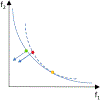Online adaptive planning methods for intensity-modulated radiotherapy
- PMID: 37068488
- PMCID: PMC10637515
- DOI: 10.1088/1361-6560/accdb2
Online adaptive planning methods for intensity-modulated radiotherapy
Abstract
Online adaptive radiation therapy aims at adapting a patient's treatment plan to their current anatomy to account for inter-fraction variations before daily treatment delivery. As this process needs to be accomplished while the patient is immobilized on the treatment couch, it requires time-efficient adaptive planning methods to generate a quality daily treatment plan rapidly. The conventional planning methods do not meet the time requirement of online adaptive radiation therapy because they often involve excessive human intervention, significantly prolonging the planning phase. This article reviews the planning strategies employed by current commercial online adaptive radiation therapy systems, research on online adaptive planning, and artificial intelligence's potential application to online adaptive planning.
Keywords: IMPT; IMRT; online adaptive radiation therapy; online adaptive treatment planning.
Creative Commons Attribution license.
Figures





Similar articles
-
Feasibility of Conebeam CT-based online adaptive radiotherapy for neoadjuvant treatment of rectal cancer.Radiat Oncol. 2021 Jul 23;16(1):136. doi: 10.1186/s13014-021-01866-7. Radiat Oncol. 2021. PMID: 34301300 Free PMC article.
-
Plan-library supported automated replanning for online-adaptive intensity-modulated proton therapy of cervical cancer.Acta Oncol. 2019 Oct;58(10):1440-1445. doi: 10.1080/0284186X.2019.1627414. Epub 2019 Jul 4. Acta Oncol. 2019. PMID: 31271076
-
Online adaptive radiotherapy for bladder cancer using a simultaneous integrated boost and fiducial markers.Radiat Oncol. 2023 Oct 6;18(1):165. doi: 10.1186/s13014-023-02348-8. Radiat Oncol. 2023. PMID: 37803392 Free PMC article.
-
Robust radiotherapy planning.Phys Med Biol. 2018 Nov 12;63(22):22TR02. doi: 10.1088/1361-6560/aae659. Phys Med Biol. 2018. PMID: 30418942 Review.
-
Adaptive radiotherapy of head and neck cancer.Semin Radiat Oncol. 2010 Apr;20(2):84-93. doi: 10.1016/j.semradonc.2009.11.002. Semin Radiat Oncol. 2010. PMID: 20219546 Review.
Cited by
-
Development and comprehensive clinical validation of a deep neural network for radiation dose modelling to enhance magnetic resonance imaging guided radiotherapy.Phys Imaging Radiat Oncol. 2025 Feb 7;33:100723. doi: 10.1016/j.phro.2025.100723. eCollection 2025 Jan. Phys Imaging Radiat Oncol. 2025. PMID: 40093656 Free PMC article.
-
Assessing population-based to personalized planning strategies for head and neck adaptive radiotherapy.J Appl Clin Med Phys. 2025 Mar;26(3):e14576. doi: 10.1002/acm2.14576. Epub 2024 Dec 3. J Appl Clin Med Phys. 2025. PMID: 39626092 Free PMC article.
-
CBCT-based online adaptive radiotherapy of the prostate bed: first clinical experience and comparison to nonadaptive conventional IGRT.Strahlenther Onkol. 2025 Aug;201(8):767-778. doi: 10.1007/s00066-024-02323-6. Epub 2024 Nov 5. Strahlenther Onkol. 2025. PMID: 39499306 Free PMC article.
-
Modeling dosimetric benefits from daily adaptive RT for gynecological cancer patients with and without knowledge-based dose prediction.J Appl Clin Med Phys. 2025 Mar;26(3):e14596. doi: 10.1002/acm2.14596. Epub 2025 Jan 27. J Appl Clin Med Phys. 2025. PMID: 39868634 Free PMC article.
-
Online Adaptive MRI-Guided Stereotactic Body Radiotherapy for Pancreatic and Other Intra-Abdominal Cancers.Cancers (Basel). 2023 Nov 3;15(21):5272. doi: 10.3390/cancers15215272. Cancers (Basel). 2023. PMID: 37958447 Free PMC article.
References
-
- Ahunbay EE and Li XA (2015). Gradient maintenance: A new algorithm for fast online replanning, Med Phys 42(6): 2863–2876. - PubMed
-
- Ahunbay EE, Peng C, Chen GP, Narayanan S, Yu C, Lawton C and Li XA (2008). An on-line replanning scheme for interfractional variations, Med Phys 35(8): 3607–3615. - PubMed
-
- Ahunbay EE, Peng C, Godley A, Schultz C and Li XA (2009). An on-line replanning method for head and neck adaptive radiotherapy, Med Phys 36(10): 4776–4790. - PubMed
-
- Ahunbay EE, Peng C, Holmes S, Godley A, Lawton C and Li XA (2010). Online adaptive replanning method for prostate radiotherapy, Int J Radiat Oncol Biol Phys 77(5): 1561–1572. - PubMed
-
- Ajdari A, Ghate A and Kim M (2018). Adaptive treatment-length optimization in spatiobiologically integrated radiotherapy, Phys Med Biol 63(7): 075009. - PubMed
Publication types
MeSH terms
Grants and funding
LinkOut - more resources
Full Text Sources
Other Literature Sources
Research Materials
